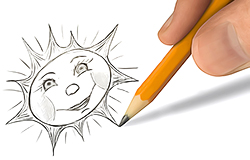Little children learn a lot when they are not aware that they are being taught. As parents, my wife and I try our best always to find ways to weave learning into our three year old son’s play. As early as when he was two years and a few months old we introduced our son to the world of visual arts. I was into drawing and painting, so it was only natural for me to at least expect that my little boy would have some artistic inclinations, too.
 We bought him large crayons, of course the non-toxic ones that are safe for children. My wife told me that big crayons are better than the normal sized ones because kids as young as two or three do not have the motor skills yet for handling smaller objects. My son thought that the crayons were toys (big and fat crayons look like rocketships), and he played with them. I showed him how to make some lines with the crayons, but he managed only to make some unrecognizable slashes and hashings. It did not take long for me to notice that he was not interested in making lines or copying the lines I showed him. I was a bit disappointed. My wife suggested that we try to buy him bigger sheets of paper to draw on because small children have trouble making small arm and finger movements, and the small sheet could somehow hamper our son’s freedom of expression. So, we bought large drawing sheets for him.
We bought him large crayons, of course the non-toxic ones that are safe for children. My wife told me that big crayons are better than the normal sized ones because kids as young as two or three do not have the motor skills yet for handling smaller objects. My son thought that the crayons were toys (big and fat crayons look like rocketships), and he played with them. I showed him how to make some lines with the crayons, but he managed only to make some unrecognizable slashes and hashings. It did not take long for me to notice that he was not interested in making lines or copying the lines I showed him. I was a bit disappointed. My wife suggested that we try to buy him bigger sheets of paper to draw on because small children have trouble making small arm and finger movements, and the small sheet could somehow hamper our son’s freedom of expression. So, we bought large drawing sheets for him.
With the bigger drawing sheets my son started to make more explorations and discoveries with his big crayons. I stopped teaching him how to draw straight lines or simple shapes, I just watched him while he covered the sheets with unrecognizable slashes and scrawls and what seemed to be directionless lines. Then, as he produced more and more sheets full of crayon scrawls, I noticed that there was some sort of pattern in how he chose the colors to apply on the sheets. He did not use colors at random, he tended to use them in pairs. That was an improvement, at least he knew his colors. Then later on shapes began to become more and more recognizable. I started to ask him questions about his “art”. “What is this?” I asked him, pointing to something that looked like a mangled fish. “It’s a house”, he told me. “And this is a tree, and this is a little puppy”, he continued to explain the other unrecognizable shapes he made on the sheets.
I realized that everything he placed on the sheet had meaning to him, he was actually expressing something in his art in his own way. I learned a lot from him that day.











Isn’t it interesting just how much parents can learn when they aren’t aware that they are being taught???
that’s a good way to encourage him the way you do c: you must not put skills in a box let him express his art by the way he wants it. maybe he likes abstract art c; maybe also it’s too early to tell.one step at a time c: